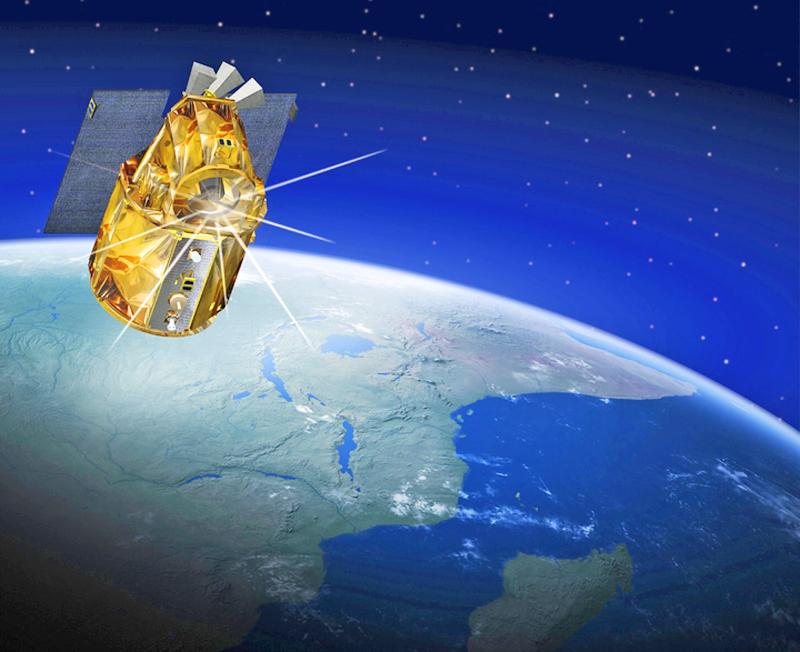Taiwan’s plan to issue licenses for the delivery of low Earth orbit (LEO) satellite services is a major strategic move for the country and would create great business opportunities for relevant industries, analysts said.
For example, if Taiwan’s underground and undersea fiber optics were damaged during a war, LEO satellites, which normally operate below an altitude of 2,000km, could be a powerful tool for the military, Digitimes research analyst Ashley Huang (黃雅芝) said in a telephone interview.
There is evidence of the value of LEO satellites in wartime, for example Ukraine’s effective use of LEO data in the war against Russia, Huang said.

Photo courtesy of the National Space Organization
In addition to the satellites’ strategic value to a nation, they also have the potential to boost the satellite phone market, which would generate new business opportunities under Taiwan’s plan to issue LEO satellite licenses to domestic telecoms, Huang said.
Universal Microwave Technology Inc (昇達科技), a leading Taiwanese supplier of millimeter-wave passive components to international space companies, said it is eager to see the launch of the LEO satellite business in Taiwan, as it is aiming to venture into the satellite component market.
If the government decides to accept license applications from global LEO satellite service providers, major companies such as Space Exploration Technologies Corp, Telesat Corp, OneWeb Ltd and Amazon.com Inc are likely to apply, Universal Microwave Technology said.
Meanwhile, two Taiwan-based companies have expressed interest in the emerging LEO communications market: Auden Techno Corp (耀登科技), a supplier of wireless local-area network antenna and radio frequency technology products, and Accton Technology Corp (智邦科技), a leading provider of networking solutions.
The National Communications Commission in March approved draft rules for the appropriation and assignment of radio frequency bands for satellite communications, paving the way for license applications from telecoms to provide LEO satellite services.
To be eligible to obtain such licenses, telecoms must be registered in Taiwan and managed by Taiwanese, the commission said.
However, foreign operators can form partnerships with Taiwanese companies to apply for the licenses, it said.
Market researcher TrendForce Corp (集邦科技) said in a report released last year that LEO satellites’ signal coverage is not constrained by geographical features, such as mountains, oceans and deserts, which means they can synergize with 5G mobile communications to reach areas that lack 5G coverage.
In the global satellite market, LEO satellites also have the greatest developmental potential, given their proximity to Earth and their relatively lower latency, radiation and cost compared with high Earth orbit and medium Earth orbit satellites, TrendForce said.
It forecast that the global satellite industry would generate revenue of US$295 billion this year, an annual increase of 3.3 percent.

MULTIFACETED: A task force has analyzed possible scenarios and created responses to assist domestic industries in dealing with US tariffs, the economics minister said The Executive Yuan is tomorrow to announce countermeasures to US President Donald Trump’s planned reciprocal tariffs, although the details of the plan would not be made public until Monday next week, Minister of Economic Affairs J.W. Kuo (郭智輝) said yesterday. The Cabinet established an economic and trade task force in November last year to deal with US trade and tariff related issues, Kuo told reporters outside the legislature in Taipei. The task force has been analyzing and evaluating all kinds of scenarios to identify suitable responses and determine how best to assist domestic industries in managing the effects of Trump’s tariffs, he

TIGHT-LIPPED: UMC said it had no merger plans at the moment, after Nikkei Asia reported that the firm and GlobalFoundries were considering restarting merger talks United Microelectronics Corp (UMC, 聯電), the world’s No. 4 contract chipmaker, yesterday launched a new US$5 billion 12-inch chip factory in Singapore as part of its latest effort to diversify its manufacturing footprint amid growing geopolitical risks. The new factory, adjacent to UMC’s existing Singapore fab in the Pasir Res Wafer Fab Park, is scheduled to enter volume production next year, utilizing mature 22-nanometer and 28-nanometer process technologies, UMC said in a statement. The company plans to invest US$5 billion during the first phase of the new fab, which would have an installed capacity of 30,000 12-inch wafers per month, it said. The

Taiwan’s official purchasing managers’ index (PMI) last month rose 0.2 percentage points to 54.2, in a second consecutive month of expansion, thanks to front-loading demand intended to avoid potential US tariff hikes, the Chung-Hua Institution for Economic Research (CIER, 中華經濟研究院) said yesterday. While short-term demand appeared robust, uncertainties rose due to US President Donald Trump’s unpredictable trade policy, CIER president Lien Hsien-ming (連賢明) told a news conference in Taipei. Taiwan’s economy this year would be characterized by high-level fluctuations and the volatility would be wilder than most expect, Lien said Demand for electronics, particularly semiconductors, continues to benefit from US technology giants’ effort

ASML Holding NV, the sole producer of the most advanced machines used in semiconductor manufacturing, said geopolitical tensions are harming innovation a day after US President Donald Trump levied massive tariffs that promise to disrupt trade flows across the entire world. “Our industry has been built basically on the ability of people to work together, to innovate together,” ASML chief executive officer Christophe Fouquet said in a recorded message at a Thursday industry event in the Netherlands. Export controls and increasing geopolitical tensions challenge that collaboration, he said, without specifically addressing the new US tariffs. Tech executives in the EU, which is